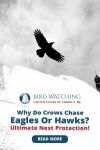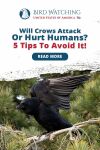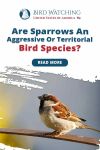
What’s This Post About?
If you are someone who likes to spend most of their time outside, you might have noticed a group of crows chasing away an eagle or a hawk. But did it occur to you that this behavior looks rather strange? Aren’t crows a little smaller in size than those bulky raptors?
Well, to answer your questions and curiosities, crows are exceptionally good at scaring away just about any being; the size has never been a problem! They can be seen chasing after cats, hawks, eagles— and humans!
But another interesting question is; how do crows get away from such situations without risking their lives? Keep reading to find out more about these birds.
Crows chase and attack eagles to protect their nest and their surroundings from any kind of threat or danger. Eagles are known as nest robbers so to protect their nest and babies against raptors, crows chase eagles away.

Crows and Their Mobbing Behavior
Mobbing birds are some real bullies when it comes down to it; they will lunge at, dive-bomb, harass, and even go as far as pooping on an animal or a person that they consider a threat. This is done specifically to deter intruders and predators.
Almost all the members of the Corvid family have an aggressive mob mentality. When one is in trouble, the rest of the flock comes to the rescue—their attacks are coordinated, which gives them an edge over their victims/enemies.

Similarly, when a crow is chasing after eagles, they can easily get away with it since they have a stronger ‘social behavior’ compared to them. Their strength mainly comes from the number of crows that join in to chase away threats.
Crow’s Social Behavior
Crow’s social behavior is what makes them stand out amongst the whole bird kingdom. Crows are mainly known for their family ties. They have really close relationships with their families; hence always bring in the company of other crow fellows.
The fact that crows stay closely in touch with their non-mating partners speaks a lot about their close ties. Like every other bird, they have a core nesting season where families are made by joining a mating pair, but this does not break a crow’s ties with their previous flock.
This behavior alone proves a crow’s socializing habits, i.e., they socialize with a large group compared to other birds. The reason being that the other birds mostly break ties once they find new mating partners, whereas crows don’t.

A crow’s strength lies in the number of other crows. Once they finish nesting, crow families fly away to meet other crow families and join them to create an even bigger group. This cycle continues.
Crows sleep and travel in flocks. Their behavior of living in a flock is what helps them protect themselves. They team up to attack or chase away threats, and in some cases, chase food from other birds such as eagles.
Eagle’s Social Behavior
Eagles have well-defined territories. Unlike crows, an eagle doesn’t have a group of other eagles’ support. Eagles are usually alone with large colonies. This is because their size and strength are enough to keep them protected. Social skills are a secondary idea; therefore, it’s the least developed trait in them.

This solitary pair method helps them against other large raptors. However, in the case of crows, this strategy does not work mainly because of a crow’s speed and large groups lunging at them. Once crows form a group to chase or attack eagles; eagles are usually left defenseless and defeated.
In case an eagle crosses a crow’s territory, you can see a scene of crows chasing an eagle mainly for the following two reasons:
- To snatch away the food
- To keep eagles out of their territory
Due to the eagle’s solitary nature, eagles are left with no choice but to escape that situation and return to their territories.
Why Do Crows Attack Eagles?

Crows can be seen attacking an eagle mainly for the following three reasons:
Protection of Their Nests
Crows are famous for stealing food from eagles as a defensive measure. And since eagles are commonly known as nest robbers, they are most likely to attack a crow’s nest or a baby crow, potentially upsetting the parent crows.
To save their homes, crows attack eagles. Eagles look out for an opportunity to attack a crow’s home and eat its eggs. However, thanks to the crow’s speed, height, and relatives, they can quickly surround and scare away the Eagle. This helps crows to chase and keep eagles away from their nests.
Marking Territories
Another reason why crows attack eagles are due to competition. During their early nesting days around late winter, they compete for nesting sites. Both of them look for better places and hence have similar nesting preferences.
The factors they lookout for while fighting over nest sites are:
- Abundance of Food
- Limited Nest Site
- Good Locations (Near Sun or Sea)
Similar Eating Preferences

This is one of the most common reasons why crows attack eagles. One common fight these two birds have is over food. If you ever see an eagle hunting down its prey or munching on some dead animal’s remains, you will notice crows surrounding the eagles.
The reason behind this is mainly a crow’s protectiveness towards its nest and nestlings. Stealing the food usually happens when an eagle hunts near or in a crow’s territory.
Crow’s Habitat
Crows prefer living in areas with enough room to breathe and mingle with the rest of the crows. As we know, crows’ strength lies in their groups. Their nature of staying in the flock has helped them fight attacks and intruders. Moreover, crows are omnivores; this helps them live in different environments with different sources of food.

Crows can stay put in areas with different landscapes. They do so by bumping up next to each other since they travel in flocks. Subsequently, this group travel helps them to hide their nests.
Crows are known for living in different ecological zones. However, crows can now be seen in residential areas. The reason is that human activities have spread so much that it has transformed forest landscapes into farms, farmlands, and lawns.
Eagle Habitat
Eagles prefer staying alone, unlike crows. They are known for their abilities to remain above the water bodies and hunt food for themselves. An eagle’s habitat is much more restricted than that of other birds.

Eagles have different preferences, especially regarding their habitat needs. They are known for being an edge species. Unlike crows, eagles cannot occupy any edge habitat. They prefer bigger trees, open landscapes, and water bodies.
Eagles love to feed on fish. This is why they prefer habitats near water bodies. However, they can also eat land-based creatures such as rabbits, squirrels, or mice.
How Do Eagles and Crows Run Into Each Other?

A few groups of crows will be noticed interfacing with hawks on a daily basis. Crows like to live in edge zones, i.e., between water and land. They tend to fly in between the areas where they bump into eagles.
How Does A Crow Attack a Raptor?
Crows always attack in groups. Eagles are large, powerful birds that a crow can never handle alone. Here are a few tricks that a crow uses against an eagle:
- Since crows are smaller in size as compared to eagles, they cannot fight it alone. Hence, teaming up with other crows helps them in chasing and stealing food from eagles.
- Crows fly together in a synchronized manner, making it difficult for the eagle to fight back to defend itself. Crows surround the eagles and dive around them to create a distraction.
- Since they fly around in flocks when chasing an eagle, it helps them stay persistent, especially to fly high above an eagle—they mob an eagle, which helps them fight off larger birds, mostly eagles.
- The mobbing takes place with a minimum of three to four crows to a maximum of ten to twelve crows. They fly near the eagle, chanting, and cawing. This noise makes the eagle feel intimidated, especially because of the large group of crows.
Do Eagles Kill Their Prey?

Eagles, just like any other raptor, kill their prey using their claws. Their nails are sharp and strong, which usually help kill their prey on the spot.
Bald eagles are known for their power and size. They are considered as one of the most powerful birds as it is surprisingly good at dipping into the rivers while still maintaining its speed. An eagle will pick a roost close to the waterway or lake to investigate things.
Moreover, they have a mind-boggling vision. Eagles are known for their powerful eyesight and ability to zoom in from a long distance. When chasing, you’ll regularly see them picking a high roost where they can sit and watch from above, searching for promising circumstances.
If Eagle Is A Powerful Bird, Why Doesn’t It Fight Back?

It is no lie that eagles are among the largest and most powerful predators amongst all the birds. So, of course, they do fight back.
Bald eagles kill and feed on crows, both young and adults. This happens when a crow misses its chance. For instance, if it gets caught alone, takes risks, or misses the flow and gets separated from the flock.
Crows usually follow eagles when it is necessary. The reason being that there is consistently a potential danger when taking on a particularly risky contender. All creatures have the endurance impulse to attempt to stay away from the struggle at whatever point conceivable.
Once crows develop a feeling of safety, they will leave the bird in harmony and direct their concentration toward different things. Likewise, when an eagle feels no danger, it will not attack.
Keep Reading!
Crows and eagles can be seen fighting most of the time. This happens when either of the two birds feels danger around the presence of the other. But this scenario is often misunderstood as eagles chasing a crow, where in reality, it is the other way round; crows chasing eagles.
Although eagles are known as the largest and most powerful predato_rs in the bird species, they can still not fight against crows because of a crow’s ability to fly and chase in groups. Crows team up while chasing an eagle. This helps crows to stand strongly against such a large predator.
Are you curious to learn more about crows?
What Does Seeing 3 Crows (Or Ravens) Really Mean?
Did you recently see a crow and were left wondering what it means? Read ahead to find out what seeing crows generally means.

By David A. Swanson
Bird Watching USA
My name is David and I'm the the founder of Bird Watching USA! I started Bird Watching with My father-in-law many years ago, and I've become an addict to watching these beautiful creatures. I've learnt so much over about bird watching over the years that I want to share with the world everything I know about them!

David A. Swanson
Bird Watching USA
My name is David and I'm the the founder of Bird Watching USA! I started Bird Watching with My father-in-law many years ago, and I've become an addict to watching these beautiful creatures. I've learnt so much over about bird watching over the years that I want to share with the world everything I know about them!









